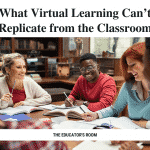The end of summer is synonymous with returning to class and back-to-school shopping. This is as much a tradition as preparation for the upcoming year. However, not every student will have the same experience shopping for pens and notebooks. Some will be looking for laptops and headphones. But even with our experience during COVID-19, first-time virtual students are entering an unfamiliar world of learning.
Virtual learning has its share of issues–slow internet, social disconnection, a lack of cohesion between teacher and student—which cause many people to turn away because of the hassle. As a student and a first-time teacher, I have had my skepticism toward the efficacy of online learning. Since then, years later, I have discovered the potential to optimize learning in a virtual setting has always been there.
So, after asking my virtual colleagues to share their advice on welcoming new virtual students, I have compiled a few tips to offer that will help make the transition from traditional to virtual swift and smooth:
Improve Your Learning Environment
A well-decorated classroom can be a powerful thing, even a learning tool. As a virtual teacher, I did what I could by sprucing up my desk until it felt like a sanctuary where I could teach in Zen. I want my students to be able to accomplish the same state of mind.
To accomplish this, a little attention to where they learn is needed. In traditional classrooms, students don’t always get to decorate their desks. In a virtual classroom, their bedroom is the classroom. They can express themselves however they want with their desk, increasing comfortability (and potentially confidence) in their learning environment.
Encourage consistency with where they participate in classes and complete their work. The history teacher I work with expressed the importance of “going to the same spot every day may help mentally transition the student from free time to school time.” Failing to create a practical learning environment from both the teacher’s and student’s end will lead to complications in the initial transition.
Manage Time for Learning and Relaxing
In addition to having a comfortable learning space, maintaining a schedule is vital to success. “Without structured time for different subjects,” the head of the school I teach under said, “students end up putting assignments off.” This is the highest and most common hurdle that first-time virtual students face.
The appearance of abundant free time is an easy trap to fall into and can be avoided with a little time management. The role of who oversees this has been reversed, as observed by my fellow language arts teacher. The student (with help from their parents) must now determine how their time is spent. She noticed that students can find both more and less time to put toward learning.
It is easy to avoid schoolwork when teachers and students are rarely face-to-face, so emphasizing the need to create a schedule is nothing but beneficial. Even the most basic of schedules can make a difference.
Communication Often
Classrooms inherently promote social interaction more than classes on Zoom, which allows for the fluidity between teacher and learner to grow with greater ease. One method you can use to imitate the feeling of a traditional school is to keep in contact with your students and their parents. This means more than weekly check-ins and reminders for upcoming due dates. Engage with their experience more. Compliment them for small victories. Inspire them to push through bad grades. The communication pathway will only grow as the year goes on.
Embrace Online Interaction
The computer screen is our gateway to interacting in a live session. Yet, it often functions as a wall to hide behind for many students. This hesitancy to embrace the online learning environment is because everyone is front and center when interacting rather than being a part of the crowd. It can be unnerving for young students.
The likelihood of a student suddenly finding the bravery to jump headfirst into the deep end is slim, so the responsibility falls more on the teacher than on the student. To accomplish this, keeping the material fresh and exciting is helpful. The world’s attention is already fixed on online feeds. Use this to your advantage. I love surprising a class with fascinating websites or viral videos and showing them I’m not completely detached from pop culture.
While kids these days live in the digital world, there is still much for them to learn about the functionality of modern technology, especially the World Wide Web.
Utilize Virtual and Traditional Learning Tools
The presence of smart tech exists deeply in our personal and professional lives, but not always in harmony. These devices can enhance our lives but are equally capable of hindering our connection to the physical world. This is why we must strive for a healthy relationship with technology.
If we can convince students that technology is a tool akin to a textbook or calculator, then a healthy relationship can begin. One of my colleagues who teaches mathematics said it is important to “merge the traditional with the virtual.” Trimming down the time spent online may improve the student’s productivity. This can be accomplished by encouraging taking notes or brainstorming on paper. The benefits of tactile engagement will always be there. Engage with your surroundings.
While holding on to traditional practices in online environments is useful, teaching students how to utilize the technology at their fingertips fully is arguably more important. Skills such as online research are necessary to operate in an increasingly digital world, making tech savvy a high-demand talent.
Orienting first-time virtual students can be difficult. Providing as much advice and support as possible is important to make this transition bearable. Every student will be different, so once the groundwork has been laid and the student seems comfortable in their digital world of learning, you can start working on the more important connection between teacher, student, and material. That is where true learning begins.
Spectrum of Success and Failure
From conversing with my team, I have learned that virtual learning has the widest spectrum of success and failure. Ultimately, the decision falls on the students (and, to a degree, the parents) on whether to embrace it, but the educator’s role as a motivator should not be sold short. For the students who don’t embrace their new learning environment, the learning gap seems to expand exponentially. For those that do, I have never seen more college-ready students in my life. We can empower our virtual students to keep pace with the digital world by laying the foundation alone.







